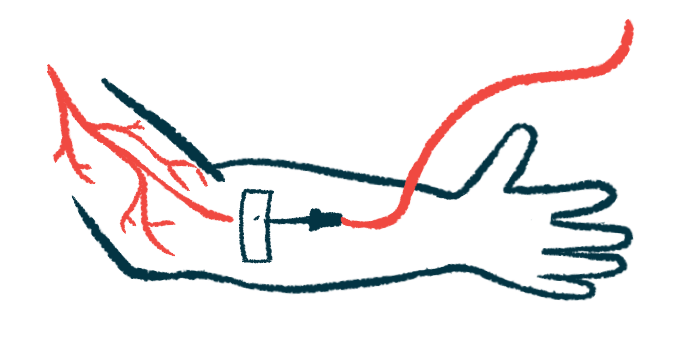Low dose of corticosteroids as good as high dose for AAV: Study
Intravenous methylprednisolone found safe, effective in patients
Written by |

A low dose of intravenous or into-the-vein methylprednisolone, a corticosteroid, is as safe and effective as a high dose at preserving kidney function and extending survival in people with severe ANCA-associated vasculitis (AAV), a U.K. study found.
Given that corticosteroids, a standard AAV treatment, are associated with significant adverse events, these findings suggest that lower doses, with a more favorable safety profile, may successfully manage severe AAV.
“Reduced [intravenous] methylprednisolone and radical steroid avoidance strategies have been shown to have no significant adverse effect on [patient] outcomes,” the researchers wrote.
The study, “Low Dose Intravenous Methylprednisolone in Remission Induction Therapy for ANCA-Associated Vasculitis,” was published in the journal Kidney360.
Testing lower versus higher doses of intravenous methylprednisolone
AAV causes small blood vessels to become inflamed and damaged. When this happens in the kidneys, they may stop working properly over time, ultimately leading to kidney failure.
While anti-inflammatory corticosteroids are often used to induce disease remission, they tend to cause considerable side effects if taken for a long time or at a high dose. Such adverse events can include weight gain, high blood sugar or diabetes, high blood pressure, weakening of the bones, mood changes, and increased risk of infection.
Earlier work has shown that oral corticosteroids can be used at a lower dose yet still be “safe and effective” for AAV, the researchers wrote. However, they noted that “there is comparatively very limited guidance regarding the role of intravenous (IV) methylprednisolone (MTP) as part of remission induction therapy.”
To learn more, a team of researchers in the U.K. looked back at data from 65 adults who had been newly diagnosed with AAV. All received treatment with intravenous methylprednisolone between 2007 and 2022 at a single center in the U.K. Each had AAV-associated kidney disease.
The patients’ mean age was 69, and nearly one-third (32.3%) required dialysis to replace the normal blood-filtering function of the kidneys.
The high-dose group comprised 34 patients who received intravenous methylprednisolone at a dose of 1.5 grams over three days, followed by a tapering course of oral methylprednisolone starting at 40-60 mg per day.
The low-dose group included 31 patients given a single intravenous methylprednisolone infusion at a six times lower dose (250 mg), followed by a tapering course of oral methylprednisolone starting at 30 mg a day.
Given that the low-dose regimen was implemented more recently in the health center, patients in that group were followed for a shorter period than those in the high-dose group. Overall, the low-dose group was followed for about one year, versus a total of five years for those on the higher dose.
All of the patients received methylprednisolone along with immunosuppressive agents, such as cyclophosphamide (39 patients), rituximab (11 patients), and a combination of both (15 patients).
The low-dose group had fewer men (26.5% vs. 73.5%) and scored lower in a measure of simultaneous health conditions (3.6 vs. 4.6) than the high-dose group. Patients given the low-dose of IV methylprednisolone also had a higher burden of kidney disease, with fewer normal glomeruli, the blood-filtering small blood vessels (33.3% vs. 48.2%).
However, at six months of follow-up, the proportion of patients in the low-dose group who progressed to kidney failure was not significantly different to that of the high-dose group (38.7% vs. 23.5%. The same was observed at one year (38.7% vs. 29.4%) and at the end of the study (38.7% vs. 32.4%).
Fewer deaths, hospitalizations in low-dose group
There were 11 deaths in total — nine in the high-dose group and two in the low-dose group. This difference nearly reached statistical significance.
The researchers noted that three of these deaths occurred within the first year of follow-up, specifically two in the high-dose group and one in the low-dose group.
Remission was achieved by all patients in the high-dose group and most (96.8%) in the low-dose group. However, the low-dose group achieved remission significantly faster, by about a month (97 vs. 127 days).
Relapse rates and time to relapse were comparable between the groups.
Glucocorticoid-related side effects occurred less frequently in the low-dose group than in the high-dose group (29% vs. 44%), but the difference failed to reach statistical significance.
Patients in the low-dose group gained a mean 0.2 kg (about 0.4 pounds) over a period of up to six months from diagnosis, while those in the high-dose group put on an average of 2 kg (4.4 pounds).
Importantly, fewer patients in the low-dose than the high-dose group — one versus six —developed severe infection requiring hospital admission.
We suggest this [work] be a platform for larger studies looking at reduced/no [intraveneous methylprednisolone] in the management of AAV alongside significantly lower cumulative [corticosteroid] dosing.
“Our study demonstrates no significant difference in treatment outcomes, including mortality, [kidney failure] or relapse rates when using reduced dose of IV MTP and lower overall cumulative dose of [glucocorticoids] compared with standard practice,” the team wrote, noting that “this was observed despite the presence of more advanced [kidney] impairment … at presentation in the low dose group.”
These findings highlight that “markedly reduced cumulative glucocorticoid dosing for remission induction therapy in AAV is safe and effective,” the researchers wrote.
“We suggest this be a platform for larger studies looking at reduced/no IV MTP in the management of AAV alongside significantly lower cumulative [corticosteroid] dosing,” the team wrote.
Still, they noted that their study was limited by its small sample size and by its retrospective nature, suggesting that larger studies, following patients over time, are needed to confirm these findings.






